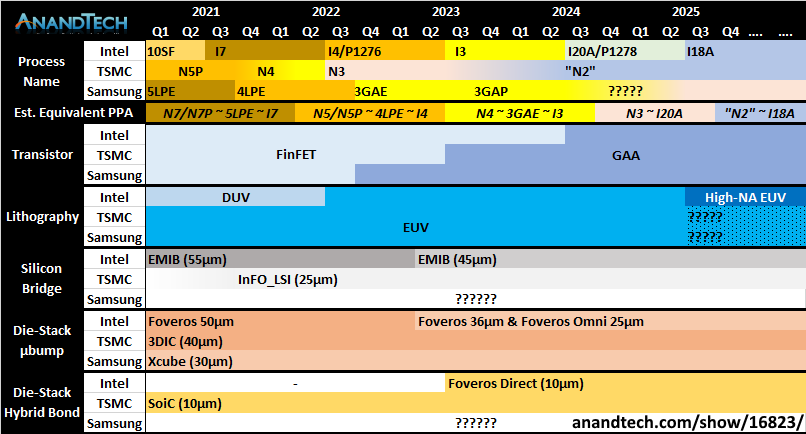Intel's Process Roadmap to 2025: with 4nm, 3nm, 20A and 18A?!
by Dr. Ian Cutress on July 26, 2021 5:00 PM ESTCustomers Customers Customers
As a roadmap announcement today, the focus isn’t so much on the customers but on the technology. Because Intel is moving into a phase where it expects its IFS offerings to compete against the established players, it has to consider its disclosures with respect to both its internal use and any external interest, which is a new concept for the company – at least on this scale compared to its previous foundry efforts.
Intel CEO Pat Gelsinger, in the company’s Q3 financial call last week, was keen to point out that they already have a large hyperscaler customer signed up for their next generation packaging technology, however today there would appear to also be another customer in the mix. Now we assume that Intel’s Foundry Services is talking to 100s of chip companies, big and small, but it doesn’t take much to sign an NDA to start to talk – what will be interesting is when customers start making commitments to using Intel’s facilities, and if any of those are volume orders.
As part of the announcement today, Intel held a little bit back from us, saying that they are saving some of the details specifically for the event that is going on as we publish this piece. All we know is that our draft press release has a big yellow bar that says ‘[customer news]’ on it, right next to Intel’s 20A process node details.
For reference, Intel 20A is a 2024 technology using first generation Gate-All-Around transistors, marketed as RibbonFETs, as well as backside power delivery, marketed as PowerVias. At this time Intel expects to have second/third-generation EMIB available as well as fourth-generation Foveros Direct. So if a customer is already committing to Intel 20A, there’s going to be a lot of potential here.
When the announcement is made, we will update this news article.
To conclude, Intel maintains that these roadmaps will showcase a clear path to process performance leadership* by 2025. It’s a tall order, and the company has to execute better than it has in recent memory - but that’s kind of why the company has rehired a number of former Intel experts and fellows in research, product design, and execution.
*as measured by performance per watt at iso-power
Here's a secondary comparison chart (compared to the one on page one) with all three main foundry offerings listed in each of the main segments that Intel has discussed today.











326 Comments
View All Comments
mode_13h - Thursday, July 29, 2021 - link
> Kilosecond is weird because we don't use a base ten time system.It seems you've never heard of Metric Time!
martinpw - Monday, July 26, 2021 - link
They tried that, but nobody else followed their lead.arashi - Monday, July 26, 2021 - link
That's right, if you can't lead, follow.Is that what Intel wants to do?
Lord of the Bored - Thursday, July 29, 2021 - link
Wouldn't be the first time.Ask Intel how they feel about AMD64 some time.
mode_13h - Monday, July 26, 2021 - link
Who cares if nobody follows? That's actually better, because then people have to compare based on actual metrics instead of some fake metrics that don't really tell you anything!martinpw - Tuesday, July 27, 2021 - link
The point is they did it and nobody else followed, so therefore nobody uses transistor density as a metric for comparison, and everyone still use nm. How exactly were you thinking to force people to use the metric you want them to use?mode_13h - Tuesday, July 27, 2021 - link
Again, you don't. Intel can just go its own way, with naming. Then, people have to compare based on cost, peak performance, perf/W ...you know, the stuff that actually matters!HarryVoyager - Tuesday, July 27, 2021 - link
When did they do that? I completely missed it.martinpw - Tuesday, July 27, 2021 - link
Here is where they tried to do it:https://newsroom.intel.com/editorials/lets-clear-u...
Spunjji - Thursday, July 29, 2021 - link
It's notable that they started trying to do that right around when they were failing to get 10nm off the ground but still predicting unprecedentedly high density, and stopped trying after they got 10nm products out the door with drastically reduced density from their predictions.I don't think any of these companies want to be directly compared to each other in this way unless they're clearly winning, and as they can't always guarantee they'll be winning, it makes more sense to use nonsense-numbers backed up by half-truths.